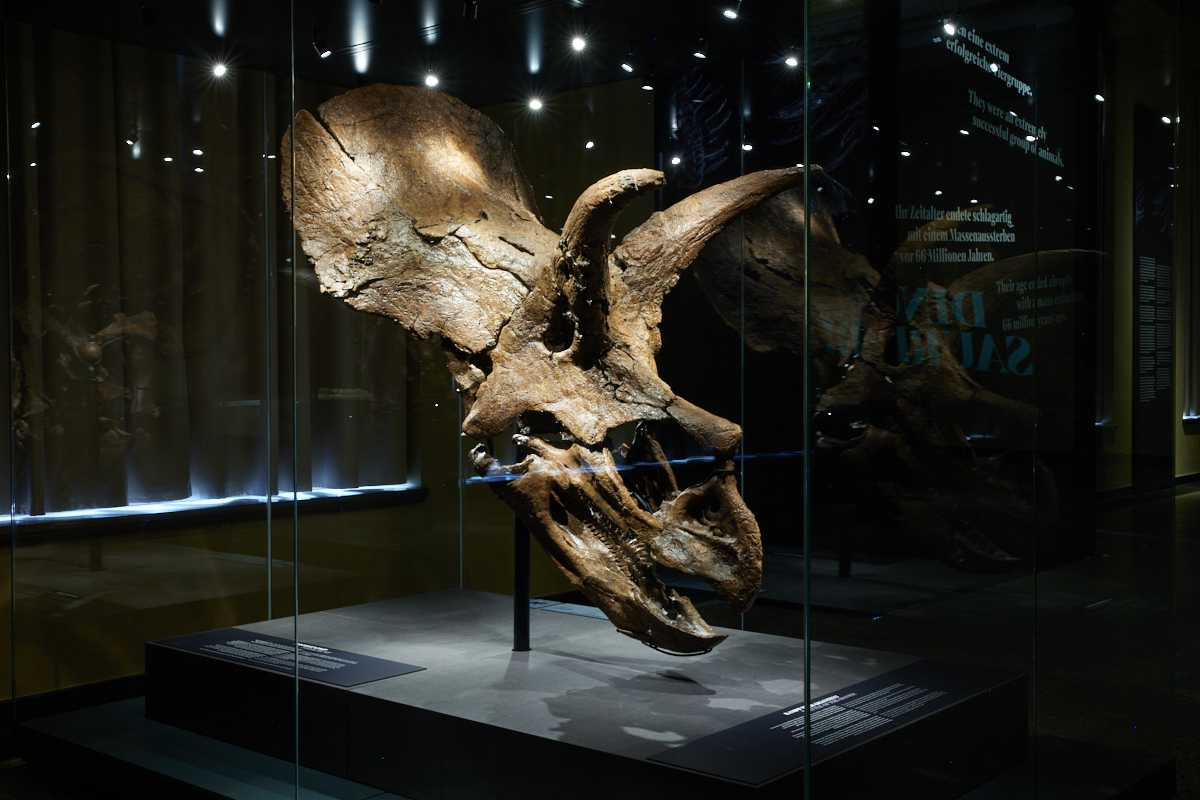New original dinosaur in Berlin's Naturkundemuseum
From now on, T. rex Tristan Otto has competition in terms of attention and popularity: the original skull of a Triceratops has moved into the exhibition "DINOSAURS! Age of the Giant Lizards" in Berlin and can be seen until the end of the year. Triceratops, which trudged across the North American continent at the same time as T. rex, impresses with its large neck shield and three protruding horns. Research on original fossils makes it possible to reconstruct ecosystems and their development up to the present day. Unlike the dinosaurs, whose ecosystem was destroyed by an asteroid at the end of the Cretaceous period, we are in control of our own destiny.
The imposing skull, measuring about 1.4m x 2 metres, was found in the Lance Creek Formation (68-66 million years old, Late Cretaceous) in Wyoming, USA. The 6-12 ton herbivore lived here in forests and plains with abundant plant cover. Its skull appears to be armoured and accounted for about a third of its body length, also giving it the name "three-horned face". Finding a dinosaur bone or other fossils – that's probably something everyone has dreamed of at some point.
In Germany, fossil finds may have to be reported and belong to the country. In the USA, on the other hand, if a fossil is discovered on private land, it is the property of the landowner. The Triceratops skull on display was discovered in 2020 by an amateur fossil hunter. The skull was prepared from the rock in Canada. Lars Fjeldsoe-Nielsen is the current owner and lender of the piece. He named the object "Amalie" after his daughter. It is impossible to say whether it is a female animal. In Triceratops, both males and females wear horns and shields.
"The Museum für Naturkunde Berlin would like to express its sincere thanks to Mr Fjeldsoe-Nielsen for this further generous loan," said Johannes Vogel, Director General of the Museum für Naturkunde Berlin. "This will enable research museums like ours to get visitors excited about nature and explore the objects."
"DINOSAURS! Age of the Giant Lizards"
As a prelude to the special exhibition, three spectacular original predatory dinosaur skulls are on display in the stairwell: the imposing skulls of T. rex Tristan Otto, Allosaurus and the skull of an extremely rare T. rex juvenile. Dinosaurs dominated our planet for more than 150 million years, making them one of the most successful groups of animals the Earth has produced.
Visitors can move through the special exhibition along the three geological eras in which dinosaurs lived. Plateosaurus, a Triassic herbivore, is not only the oldest dinosaur in the exhibition from the point of view of geological history, but also one of the earliest dinosaur finds ever made, in view of its discovery in 1834. The skeleton of the small Nanosaurus, a vegetarian, comes from the following Jurassic period. The two large skeletons of the predatory allosaurs are quite different.
At the end of the journey through the prehistoric era, T. rex Tristan Otto awaits the visitors. Together with Triceratops, he was one of the last living dinosaur species at the end of the Cretaceous period about 66 million years ago. At that time, there was an enormous variety of large and small feathered dinos. Because all forests disappeared after the asteroid impact, all species that specialised in living from and in trees as well as forests also died out. Among the surviving species are the ancestors of chickens, ducks and bouquets, which were not dependent on trees. Modern birds evolved from them – as direct descendants of the dinosaurs.
